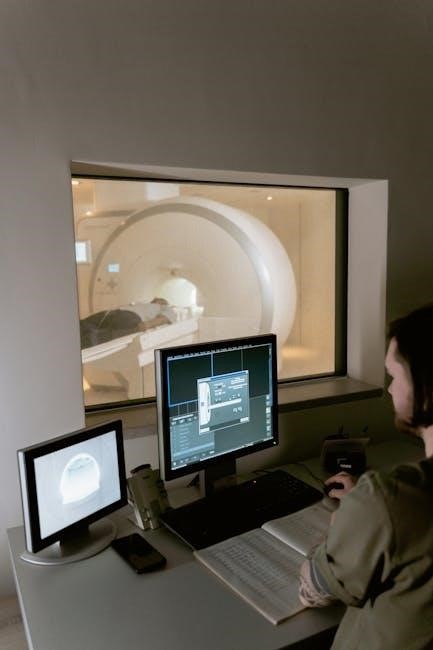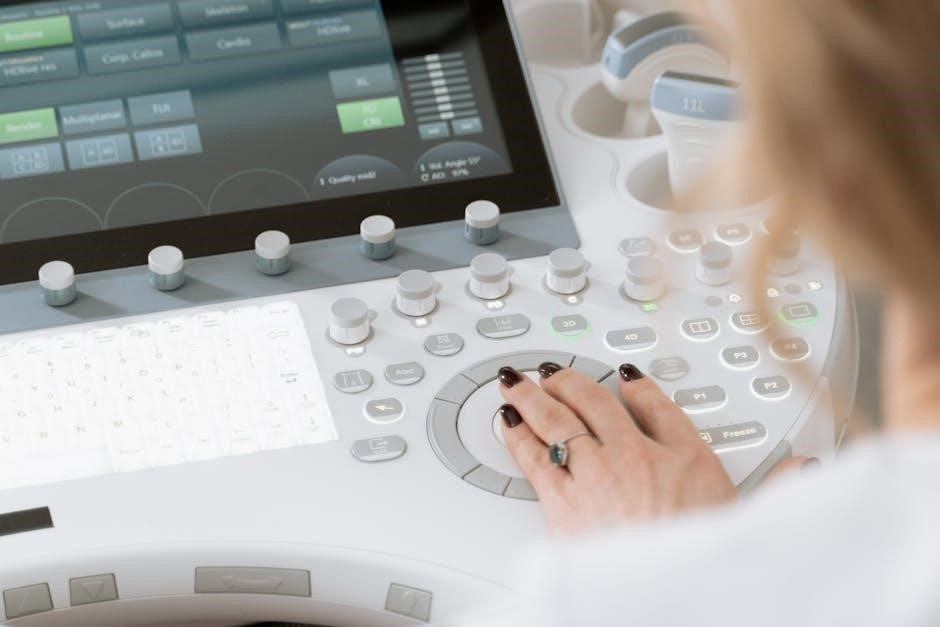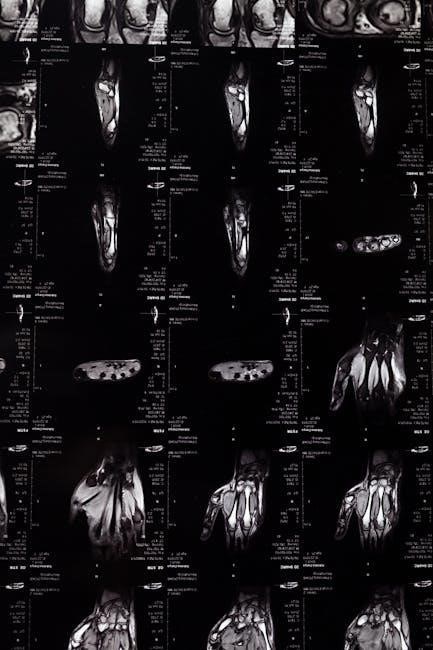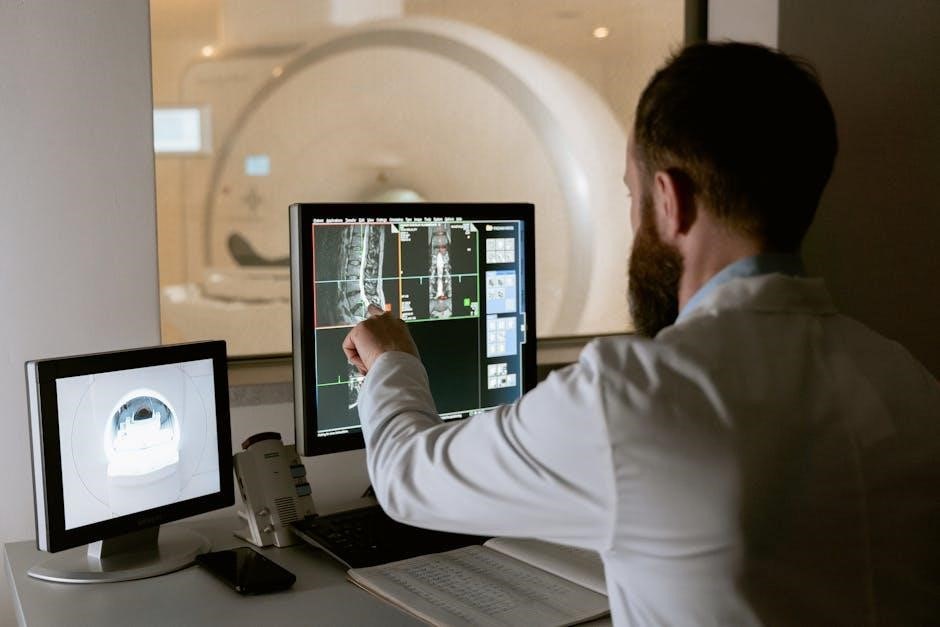Anatomy and physiology test banks are comprehensive resources offering diverse exam questions, including multiple-choice and structural identification, designed to aid students and educators in exam preparation and understanding complex topics effectively.
1.1 Definition and Purpose
Anatomy and physiology test banks are collections of exam questions designed to assess understanding of human body structures and functions. They include multiple-choice, true/false, and structural identification questions, often aligned with specific textbooks. These resources serve as valuable tools for students to practice and reinforce learning, while educators use them to create comprehensive exams. The purpose is to enhance exam preparation, improve retention, and provide a standardized way to evaluate knowledge in anatomy and physiology effectively.
1.2 Importance for Students and Educators
Anatomy and physiology test banks are vital for students, offering a structured way to practice and reinforce knowledge through diverse question types. They help identify weak areas, improve test-taking skills, and enhance retention of complex concepts. For educators, these resources streamline exam creation, ensuring assessments are comprehensive and aligned with curriculum goals. They also provide standardized questions, saving time and enabling focused instruction. This dual benefit makes test banks indispensable tools for effective learning and teaching in anatomy and physiology.

Key Features of Anatomy and Physiology Test Banks
Anatomy and physiology test banks feature multiple-choice questions, structural identification tasks, varying difficulty levels, and detailed answer keys, providing comprehensive assessment tools for both students and educators.
2.1 Multiple Choice Questions
Multiple choice questions (MCQs) are a cornerstone of anatomy and physiology test banks, offering a structured format with predefined answers. These questions vary in difficulty, from basic to advanced, ensuring comprehensive assessment. Each MCQ is accompanied by a correct answer key, facilitating self-evaluation and understanding. They cover a wide range of topics, from cellular structures to systemic functions, promoting active learning and retention. Additionally, MCQs are often updated to reflect the latest scientific advancements, making them indispensable for exam preparation and curriculum alignment.
2.2 Structural Identification Questions
Structural identification questions in anatomy and physiology test banks require students to label and describe specific anatomical structures, often accompanied by images or diagrams. These questions enhance visual recognition and understanding of complex biological systems. They are particularly effective for assessing knowledge of organs, tissues, and cellular components. Detailed answer keys provide precise feedback, helping students refine their understanding. This format is essential for developing practical skills in identifying and interpreting anatomical structures, a critical competency in medical and healthcare education.
2.3 Difficulty Levels and Answer Keys
Anatomy and physiology test banks feature questions categorized by difficulty levels, ensuring a progressive learning experience. Each question is accompanied by detailed answer keys, providing correct responses and explanations. This structure helps students assess their knowledge and identify areas for improvement. Educators can utilize these resources to create balanced exams, catering to diverse student needs. The inclusion of answer keys enhances transparency and supports effective feedback, making test banks invaluable for both teaching and learning in anatomy and physiology education.
Popular Anatomy and Physiology Textbooks with Test Banks
Popular textbooks like “Essentials of Anatomy and Physiology” by Saladin, “Human Anatomy and Physiology” by Elaine N. Marieb, and “Visual Anatomy and Physiology” by Martini/Ober/Nath include test banks.
3.1 “Essentials of Anatomy and Physiology” by Saladin
“Essentials of Anatomy and Physiology” by Saladin offers a detailed test bank with multiple-choice and structural identification questions. The PDF format allows easy access, featuring questions categorized by difficulty levels and accompanied by answer keys. This resource is ideal for both students and educators, providing a comprehensive review of anatomical and physiological concepts. The test bank is available for free download, making it a valuable tool for exam preparation and understanding complex biological systems effectively.
3.2 “Human Anatomy and Physiology” by Elaine N. Marieb
Elaine N. Marieb’s “Human Anatomy and Physiology” test bank offers a wide range of questions, including multiple-choice and structural identification, organized by difficulty levels. The PDF format provides easy access to these resources, which are designed to reinforce understanding of complex anatomical and physiological concepts. The test bank is available for free download, making it an invaluable tool for students and educators alike. Its questions emphasize the interconnected nature of human anatomy and physiology, supporting effective learning and exam preparation.
3.3 “Visual Anatomy and Physiology” by Martini/Ober/Nath
The test bank for “Visual Anatomy and Physiology” by Martini/Ober/Nath includes multiple-choice and structural identification questions, organized by difficulty levels. Available as a free PDF download, it supports interactive learning and exam preparation. Each question emphasizes the interconnected nature of anatomy and physiology, ensuring comprehensive understanding. The resource is widely used by students and educators for its clarity and effectiveness in reinforcing key concepts through diverse question formats.

Types of Questions in Anatomy and Physiology Test Banks
Anatomy and physiology test banks feature multiple-choice, true/false, and short answer questions, designed to assess knowledge retention and understanding of complex biological concepts effectively.
4.1 Multiple Choice Questions (MCQs)
Multiple Choice Questions (MCQs) are a popular format in anatomy and physiology test banks, offering students a structured way to assess their knowledge. Each question presents several options, with one correct answer. MCQs are designed to evaluate understanding of key concepts, from basic definitions to complex physiological processes. They often include difficulty levels, allowing educators to tailor assessments to different learning stages. Correct answers are provided, enabling students to track their progress and identify areas for improvement. MCQs are invaluable for exam preparation and reinforcing learning outcomes.
4.2 True/False Questions
True/False questions in anatomy and physiology test banks are concise and straightforward, testing students’ ability to identify correct statements. These questions cover a wide range of topics, from basic anatomical structures to complex physiological processes. They are designed to assess foundational knowledge and understanding of key concepts. True/False questions are often used to reinforce memorization and critical thinking, helping students distinguish between accurate and incorrect information; They are particularly useful for identifying knowledge gaps and reinforcing learning in a clear and structured format.
4.3 Short Answer and Essay Questions
Short answer and essay questions in anatomy and physiology test banks require students to provide detailed explanations of concepts, processes, and structures. These questions assess critical thinking and the ability to organize information logically. They often focus on complex topics, such as physiological mechanisms or anatomical relationships, allowing for in-depth analysis. Essay questions, in particular, evaluate a student’s ability to synthesize knowledge and present it coherently. These formats are ideal for identifying gaps in understanding and fostering comprehensive learning through detailed explanations.

Benefits of Using Anatomy and Physiology Test Banks
Anatomy and physiology test banks enhance learning by providing diverse practice questions, improving retention, and offering customizable exam preparation, helping students and educators achieve academic success effectively.
5.1 Enhanced Learning and Retention
Anatomy and physiology test banks significantly enhance learning by providing interactive questions that reinforce key concepts. Students can engage with multiple-choice and structural identification questions, improving their understanding and retention of complex topics. The inclusion of difficulty levels and answer keys allows for self-assessment, helping learners identify and focus on weak areas. Regular practice with these resources ensures better grasp and long-term retention of anatomical structures and physiological processes, making them invaluable for academic success.
5.2 Improved Test-Taking Skills
Test banks for anatomy and physiology enhance test-taking skills by familiarizing students with exam formats and question types. Regular practice with multiple-choice, true/false, and short-answer questions improves time management and reduces anxiety. Students learn to analyze questions, identify key terms, and eliminate incorrect options, sharpening their critical thinking. Access to answer keys and explanations helps refine strategies, ensuring better performance in actual exams and building confidence in tackling challenging questions effectively.
5.3 Customizable Exam Preparation
Anatomy and physiology test banks allow students to tailor their exam preparation by selecting specific topics and difficulty levels. This customization enables focused study on weak areas, ensuring comprehensive understanding. Instructors can also create personalized exams, aligning questions with course content. The flexibility of test banks empowers learners to prioritize their study time effectively, leading to more efficient and targeted preparation for assessments and improved academic outcomes overall.

How to Access Anatomy and Physiology Test Banks
Access anatomy and physiology test banks through official publisher websites, educational platforms, or free/paid resources online, offering convenient exam preparation tools for students and educators alike.
6.1 Official Publisher Websites
Official publisher websites provide direct access to anatomy and physiology test banks, often requiring instructor accounts for verified access. These platforms ensure authenticity and organization, offering downloadable PDFs aligned with specific textbooks. Many publishers, like Pearson and McGraw-Hill, feature dedicated portals for educators to download test banks, ensuring high-quality, relevant questions. Some resources may be free, while others require purchase, making them a reliable source for exam preparation materials tailored to course curricula.
6.2 Educational Platforms and Portals
Educational platforms and portals serve as key resources for accessing anatomy and physiology test banks. Websites like Pearson Higher Education and McGraw-Hill offer downloadable PDFs, test questions, and study materials. These platforms often require user registration and may cater to both students and educators. They provide organized access to resources, ensuring ease of use and relevance to specific course materials. Many portals also offer additional tools, such as question banks and study guides, to enhance learning and exam preparation.
6.4 Free vs. Paid Resources
Free anatomy and physiology test bank PDFs are available online, offering basic exam questions for students. However, paid resources provide more comprehensive and organized materials, often aligned with specific textbooks. Free options like OpenStax offer limited but useful content, while paid versions from publishers like Pearson include detailed answer keys and customizable exams. Paid resources are ideal for educators seeking structured test banks, while free versions suffice for self-study. The choice depends on individual needs and preferences for depth and convenience.
Study Tips for Using Anatomy and Physiology Test Banks
Regularly practice with test banks to reinforce concepts. Focus on weak areas and manage time effectively during exams. Utilize answer keys for self-assessment and improvement.
7.1 Regular Practice and Review
Consistently using anatomy and physiology test banks helps reinforce learning. Engage with multiple-choice and structural identification questions to build familiarity. Review answer keys to understand mistakes and track progress. Focus on weak areas to improve comprehension. Regular practice enhances retention and exam readiness, ensuring a strong grasp of complex topics. Utilize the test bank’s variety of questions to stay consistent and confident in your studies.
7.2 Focused Study on Weak Areas
Identify and address weak areas using anatomy and physiology test banks. Regularly review challenging topics and practice related questions. Focus on structural identification and multiple-choice questions to build confidence. Use answer keys to understand mistakes and track progress. Targeted study helps improve comprehension and retention, ensuring a stronger grasp of complex subjects. By concentrating on areas needing improvement, students can enhance their overall performance and approach exams with greater confidence.
7.3 Time Management Strategies
Effective time management is crucial when using anatomy and physiology test banks. Allocate specific time slots for each question type, such as multiple-choice and structural identification. Set timers to simulate exam conditions, ensuring you practice under pressure. Prioritize reviewing answer explanations within set time limits to maximize efficiency. By organizing your study sessions and adhering to schedules, you can cover more material and improve your ability to manage time during actual exams, leading to better performance and reduced stress.
The Role of Technology in Anatomy and Physiology Test Banks
Technology enhances anatomy and physiology test banks through digital platforms, interactive question banks, and AI-driven adaptive testing, providing personalized learning experiences and improving accessibility for students globally.
8.1 Digital Platforms and Apps
Digital platforms and apps revolutionize anatomy and physiology test banks by offering interactive question banks, AI-driven adaptive testing, and cross-platform accessibility. These tools enable students to practice anytime, anywhere, enhancing their learning experience. Many platforms, like Microsoft’s educational resources, integrate seamlessly with course materials, providing a user-friendly interface for accessing test banks. Apps often include features like progress tracking, difficulty adjustment, and instant feedback, making them invaluable for both students and educators aiming to improve exam preparedness and understanding of complex anatomical concepts.
8.2 Interactive Question Banks
Interactive question banks in anatomy and physiology test banks offer engaging learning experiences through dynamic features like drag-and-drop activities, 3D model identification, and clickable diagrams. These tools provide real-time feedback, enhancing understanding and retention. Many platforms integrate multimedia elements, such as videos and animations, to simplify complex concepts. Interactive question banks also allow students to track progress and focus on weak areas, while educators can customize assessments to meet specific learning objectives, fostering a more immersive and effective study environment for all users.
8.3 AI-Driven Adaptive Testing
AI-driven adaptive testing in anatomy and physiology test banks personalizes learning by adjusting question difficulty based on student performance. This technology identifies knowledge gaps and tailors assessments to individual needs, enhancing engagement and efficiency. Real-time feedback and detailed analytics help students track progress, while educators can monitor class performance. Adaptive testing fosters a dynamic learning environment, ensuring students master concepts at their own pace, making it a powerful tool for effective and personalized education in anatomy and physiology.

Common Challenges in Using Anatomy and Physiology Test Banks
Limited availability of free resources, overreliance on multiple-choice formats, and challenges in keeping up with updated editions are common issues users face when using test banks.
9.1 Limited Availability of Free Resources
Accessing free anatomy and physiology test banks in PDF format is challenging, as many high-quality resources are restricted to paid versions. While some websites offer free downloads, such as Saladin’s 3rd Edition or Marieb’s 12th Edition test banks, these are often limited in scope or require subscriptions. This scarcity forces many students and educators to rely on paid platforms or official publisher websites, highlighting the need for affordable, accessible learning tools to support academic success.
9.2 Overreliance on Multiple Choice Format
The dominance of multiple-choice questions in anatomy and physiology test banks can limit their effectiveness. While MCQs are efficient for assessing knowledge, they often prioritize recall over critical thinking. This format may not adequately evaluate a student’s ability to apply concepts or explain complex physiological processes. Overreliance on MCQs can lead to a narrow focus on memorization rather than deeper understanding, potentially undermining the development of essential analytical skills in students.
9.3 Keeping Up with Updates and Editions
Staying current with anatomy and physiology test bank updates can be challenging due to frequent textbook editions and curriculum changes. Publishers often release new versions, requiring instructors and students to adapt. Accessing the latest test banks may involve purchasing updated materials or downloading revised PDFs. This process can be time-consuming and may require frequent checks on official websites or educational platforms to ensure alignment with current academic standards and resources.
Supplementary Resources for Anatomy and Physiology
Lab manuals, study guides, online tutorials, and anatomy software complement test banks, offering hands-on practice and visual learning tools to enhance understanding of complex anatomical structures and physiological processes.
10.1 Lab Manuals and Study Guides
Lab manuals and study guides provide practical exercises, dissection guides, and detailed illustrations, complementing test banks. They offer step-by-step instructions and summaries, helping students apply theoretical knowledge. These resources often include practice questions and diagrams, reinforcing concepts learned in anatomy and physiology courses. Study guides also feature tips for effective learning and exam preparation, making them invaluable for both students and educators seeking to enhance understanding and retention of complex biological systems.
10.2 Online Tutorials and Videos
Online tutorials and videos serve as dynamic supplements to anatomy and physiology test banks, offering visual explanations of complex concepts. Platforms like YouTube and course websites provide 3D models, dissection videos, and interactive simulations. These resources help students visualize structures and processes, enhancing understanding. Many tutorials are paired with test bank questions, reinforcing learning through practical application. They are accessible anytime, making them ideal for self-paced study and review, especially for visual learners seeking to deepen their grasp of anatomical and physiological principles.

10.3 Anatomy and Physiology Software
Anatomy and physiology software provides interactive tools for exploring human structures and functions. Programs like Visual Anatomy & Physiology offer 3D models, allowing users to rotate and zoom in on organs and systems. These tools often include dissection simulations, label quizzes, and layered views to enhance understanding. They complement test banks by offering practical application of concepts, aiding in retention and visualization. Many software options are accessible online or via mobile apps, making them convenient for modern learners seeking immersive study experiences.

The Future of Anatomy and Physiology Test Banks
The future involves AI-driven adaptive testing, virtual reality integration, and personalized learning experiences, enhancing engagement and accessibility for global learners in anatomy and physiology education.

11.1 Integration with Virtual Reality (VR)
Integrating virtual reality into anatomy and physiology test banks creates immersive learning experiences, allowing students to explore 3D models of the human body interactively. This technology enhances engagement and understanding by simulating real-world anatomical structures and physiological processes. VR enables students to visualize complex systems, such as the circulatory or nervous systems, in detail. Interactive simulations can also assess knowledge through hands-on tasks, providing immediate feedback. This innovative approach aligns with modern educational trends, making learning more dynamic and accessible for future generations of students and educators alike.
11.2 Personalized Learning Experiences
Future anatomy and physiology test banks will leverage adaptive technology to create personalized learning paths for students. By analyzing individual performance, these systems tailor questions to address specific weaknesses, enhancing retention and understanding. Customizable exam preparation allows students to focus on challenging topics, fostering a more efficient study process. This personalized approach ensures that learners engage with material at their own pace, improving overall academic outcomes and preparing them for real-world applications in healthcare and scientific fields.
11.3 Global Accessibility and Collaboration
Advancements in anatomy and physiology test banks will enable global accessibility, allowing students and educators worldwide to access resources seamlessly. Cloud-based platforms will facilitate collaboration, enabling shared access to study materials and fostering a global learning community. This accessibility ensures equitable education opportunities, while real-time updates and multilingual support further enhance usability. By bridging geographical gaps, these tools promote standardized learning and collaboration, empowering users to achieve academic success collectively.
Best Practices for Instructors Using Test Banks
Instructors should align test bank questions with curriculum goals, ensuring relevance and coherence. Regularly updating assessments and providing detailed feedback fosters student understanding and engagement effectively.
12.1 Aligning Questions with Curriculum
Aligning test bank questions with the curriculum ensures relevance and coherence in assessment; Instructors should map questions to specific course objectives and key concepts, ensuring comprehensive coverage. This approach helps students focus on essential topics and reinforces learning outcomes. Regularly reviewing and updating questions to reflect curriculum changes is crucial. Additionally, incorporating study skills sections and varying difficulty levels enhances the educational value, making test banks a valuable tool for both teaching and learning anatomy and physiology effectively.
12.2 Encouraging Active Learning
Anatomy and physiology test banks foster active learning by engaging students with interactive questions and real-time feedback. Instructors can use these resources to create dynamic exams that promote critical thinking and problem-solving. Features like multiple-choice questions and structural identification encourage hands-on practice, while varying difficulty levels cater to diverse learning needs. By integrating test banks into their teaching strategies, educators can create a more immersive and collaborative learning environment, enhancing student engagement and understanding of complex anatomical and physiological concepts effectively.
12.3 Providing Feedback and Support
Anatomy and physiology test banks enable instructors to provide immediate feedback, helping students identify strengths and weaknesses. Detailed answer explanations and difficulty levels guide learners, while customizable exams allow tailored support. Educators can track progress and address specific areas needing improvement, fostering a supportive learning environment. This approach ensures students receive constructive insights, enhancing their understanding and retention of complex anatomical and physiological concepts effectively.
Anatomy and physiology test banks are invaluable tools for enhancing learning and exam preparation, offering diverse questions and resources to support academic success in this complex field.
13.1 Summary of Key Points
Anatomy and physiology test banks provide comprehensive resources for exam preparation, featuring multiple-choice questions, structural identification, and varying difficulty levels. They align with popular textbooks like Saladin, Marieb, and Martini/Ober/Nath, offering free PDF downloads. These tools enhance learning, improve test-taking skills, and allow customization for focused study. Educators can use them to create exams, while students benefit from structured practice, reinforcing complex concepts effectively. Their accessibility and diverse question formats make them indispensable for academic success in anatomy and physiology.

13.2 Final Thoughts on Effective Use
Effectively using anatomy and physiology test banks involves regular practice, focused study on weak areas, and strategic time management. Leveraging both digital and traditional resources enhances learning outcomes. By aligning test bank questions with curriculum goals, educators can foster active learning and provide constructive feedback. Students should utilize these tools to reinforce concepts, improve retention, and build confidence. Ultimately, test banks are invaluable for achieving academic success in anatomy and physiology, offering a structured path to mastery and exam readiness.
